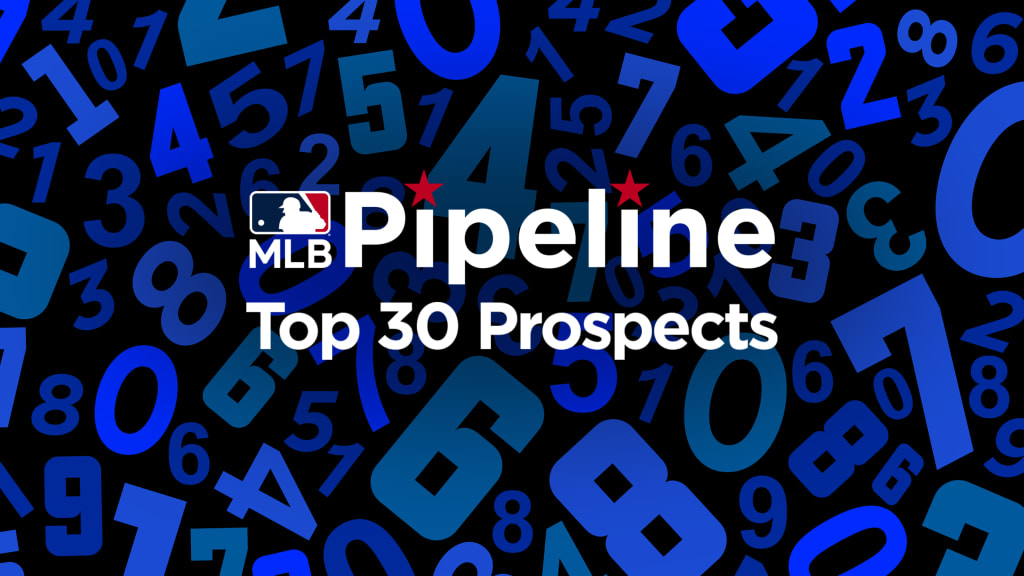
MLB Pipeline's 2022 midseason Top 30 Prospects lists have been updated for a week now. We hope you've been able to dive into all 900 scouting reports and 4,241 tool grades in order to get a feel for the next generation of Major League Baseball's stars.
Now, let's zoom out a bit and look at the big picture that all these tools collectively tell us.
Take an average of the 30 systems' overall grades -- based on the 20-80 scouting scale -- and you get something similar to the updated Farm System Rankings, released Monday night. Now, it's important to note that our Farm System Rankings are based on more than just an average of the Top 30 overall grades. Top 100 talent, overall depth and positional balance of the system are all considered as well. But it's certainly notable that many farms appear on both lists.
Moving beyond overall grades, we'll also dive into specific tool grades and find out which Top 30s are best at specific baseball skills, like overall hitting or throwing a slider. While these can vary year to year, you might be able to pick up patterns and learn that certain organizations value specific types of players (i.e. quick, defensive types or power-above-all sluggers) and model their systems after those preferences.
But bottom line: the biggest takeaway might be this -- the Orioles, Dodgers and Guardians are on a tier of their own as the best three pipelines in the game today.
Overall (farm system ranking in parentheses)
1. Guardians, 48.33 (3)
2. Dodgers, 48.17 (2)
3. Orioles, 48 (1)
4. Reds, 47.33 (4)
5. Athletics, 47 (17)
6T. Cubs 46.67 (10)
6T. D-backs, 46.67 (5)
6T. Rangers, 46.67 (6)
9. Rockies, 46.5 (9)
10. Pirates, 46.45 (7)
As we said, Cleveland, Los Angeles and Baltimore stand out as the only groups with an average overall Top 30 grade of 48 or above. The Rays (No. 8) are the only member of our Farm System Rankings Top 10 that doesn't appear above, but that's because their biggest strength is broad depth rather than high overall grades. The A's certainly shine in this metric after adding five 55- or 50-grade players in the Draft and at the Trade Deadline in Ken Waldichuk, Daniel Susac, Henry Bolte, Luis Medina and Clark Elliott.
Top 5 hitting and pitching prospects
Continuing with the theme, the Orioles, Dodgers and Guardians are the only three organizations to rank among the top five in overall hitting and pitching grades. That well-rounded nature sets the trio apart from the No. 4 Reds, who appear on one top five below and 11th on the other.
Average overall hitting grades
1. Guardians, 48.61
2. Dodgers, 48.44
3. Mets, 48.21
4. Reds, 48.1
5. Orioles, 47.95
Average overall pitching grades
1. Orioles, 48.13
2. Guardians, 47.92
3. Dodgers, 47.86
4. Marlins, 47.27
5. Pirates, 46.67
For what it's worth, the Mets had the biggest gulf in hitting and pitching groups with a difference of 5.4 points between their superior bats (48.21) and lesser arms (42.81). The Marlins' pitchers (47.27) and hitters (45.53) have the largest difference going the other direction. The Brewers (42.78), Mets (42.81) and Astros (43.46) received the lowest pitching averages, while the Phillies (44.38), White Sox (44.38) and Astros (44.71) had the lowest for hitting.
Individual tool grades
Every position player earns a grade on the 20-80 scale for his hit, power, run, arm and fielding tools. Hurlers are graded on what pitches they actually throw, but the main categories for that group are fastball, curveball, slider, changeup and control. The best organizations, along with the best individuals, for each of those are listed below, and from there, we can find some themes.
For example, the Brewers lead in run and fielding grades -- no surprise for a group loaded with fast outfielders that are all capable of playing center.
The Dodgers are represented in all four individual pitch categories, including as the leaders in fastball and changeup quality, but aren't among the top five in control, a sign of how much the organization values quality of stuff over strike-throwing in the early stages of a career.
Speaking of control, Cleveland has made a knack of taking pitchers who consistently find the zone (e.g. Shane Bieber or more recently Tanner Bibee) and improving their arsenals from there, so it shouldn't be a shock that it sits atop the group in that category.
Hit
1. Rangers, 53.3
2. Guardians, 51.7
3T. Dodgers 50.9
3T. Rays, 50.9
5. Mariners, 50.6
Hit (individual)
70: Termarr Johnson, Pirates
65: Brooks Lee, Twins; Corbin Carroll, D-backs
60: 31 players
Power
1. Mets, 55
2. Nationals, 52.1
3. Yankees, 51.6
4. Cardinals, 51.4
5. Red Sox, 51
Power (individual)
70: Francisco Álvarez, Mets
65: Jordan Walker, Cardinals; Marco Luciano, Giants; Deyvison De Los Santos, D-backs; Triston Casas, Red Sox
60: 45 players
Run
1. Brewers, 56
2. Phillies, 53.8
3. Royals, 53.4
4. Nationals, 52.6
5T. Rays, 52.2
5T. Cubs, 52.2
5T. D-backs, 52.2
Run (individual)
80: Dasan Brown, Blue Jays; Chandler Simpson, Rays; Jordyn Adams, Angels; Esteury Ruiz, Brewers
75: Casey Martin, Phillies; Brandon Lockridge, Yankees; Emaarion Boyd, Phillies
Arm
1. Astros, 59
2. Cardinals, 57.7
3. Royals, 57.2
4. Marlins, 57.1
5. Reds, 56
Arm (individual)
80: Masyn Winn, Cardinals; Jose Gerardo, Marlins; Pedro Leon, Astros
75: Gabriel Arias, Guardians
70: 16 players
Field
1. Brewers, 54.8
2. Giants, 53.9
3. Royals, 53.8
4. Rockies, 53.7
5T. Yankees, 53.1
5T. D-backs, 53.1
5T. Cubs, 53.1
5T. Phillies, 53.1
Field (individual)
70: Druw Jones, D-backs; Pete Crow-Armstrong, Cubs; Ed Howard, Cubs; Ezequiel Tovar, Rockies; Nick Pratto, Royals; Nasim Nunez, Marlins; Milkar Perez, Mariners
65: Dominic Fletcher, D-backs; Jorge Barrosa, D-backs; Joseph Ortiz, Orioles; Michael Toglia, Rockies; Shea Langeliers, Athletics; Casey Schmitt, Giants; Alika Williams, Rays
Fastball
1. Dodgers, 63.2
2. Athletics, 62.1
3. Reds, 61.7
4. Nationals, 61.5
5. Pirates, 59.2
Fastball (individual)
80: Abner Uribe, Brewers; Joe Boyle, Reds; Ben Joyce, Angels
75: Luis Medina, Athletics; Daniel Palencia, Cubs; Steven Cruz, Twins
70: 32 pitchers
Curveball
1. Marlins, 56.4
2. Rangers, 55.4
3T. Rockies, 55
3T. Dodgers, 55
3T. Athletics, 55
Curveball (individual)
65: Hunter Brown, Astros; Peyton Pallette, White Sox; Zach McCambley, Marlins; R.J. Dabovich, Giants
60: 33 pitchers
Slider
1. Giants, 58.8
2. Rangers, 57.5
3. Marlins, 57.1
4. Dodgers, 56.2
5. Nationals, 55.7
Slider (individual)
70: Connor Prielipp, Twins; Kumar Rocker, Rangers; Landon Sims, D-backs; Carlos Duran, Dodgers; Gregory Santos, Giants
65: Jackson Jobe, Tigers; Sam Bachman, Angels; Daniel Espino, Guardians; Max Meyer, Marlins; Hans Crouse, Phillies; Cade Horton, Cubs; Randy Rodriguez, Giants; Francisco Morales, Phillies
Changeup
1. Dodgers, 54.3
2T. Royals, 53.8
2T. Guardians, 53.8
4. Red Sox, 53.3
5. Brewers, 52.5
Changeup (individual)
75: Ryan Pepiot, Dodgers
70: Grayson Rodriguez, Orioles; Dylan Lesko, Padres
65: Eight pitchers
Control
1. Guardians, 51.3
2T. Rays, 50.7
2T. D-backs, 50.7
4T. Marlins, 50.5
4T. Red Sox, 50.5
4T. Cardinals, 50.5
Control (individual)
65: Landon Knack, Dodgers
60: Sixto Sánchez, Marlins; Grayson Rodriguez, Orioles; Caleb Kilian, Cubs; Tanner Bibee, Guardians; Gunnar Hoglund, Athletics; Brandon Walter, Red Sox; Jayden Murray, Astros; Jonathan Cannon, White Sox; Joe Elbis, D-backs; Dylan Dodd, Braves; Pete Hansen, Cardinals
Who’s ready to help?
We've covered tool and overall grades to this point, but it's always good to remember that those are based on future projections. We're not saying an 18-year-old could come up to the Majors and be a plus hitter tomorrow. That said, some organizations are currently front-loaded with prospects nearing The Show. The top five systems with the most 2022 and 2023 ETAs are below and include four teams within seven games of a playoff spot entering Tuesday.
1. Twins, 18
2T. Royals, 17
2T. Giants, 17
4T. Guardians, 16
4T. Yankees, 16
Youth movements
Going the other direction, systems with younger talent typically have more room to grow. In that way, there is a ray of light for Angels fans. Los Angeles ranked 30th in our Farm System Rankings, but they have the second-youngest Top 30, meaning there's ample time for this batch of prospects to develop.
Similarly, the Mariners fell from No. 2 on the preseason system rankings to No. 24 because of significant trades and graduations. The players that make up their Top 30 now are the youngest in the game, providing Seattle with the hope that they can increase their stock with experience.
1. Mariners, 10/23/2001
2. Angels, 7/6/2001
3. Nationals, 4/7/2001
4. Brewers, 4/2/2001
5. Phillies, 3/30/2001
6. Blue Jays, 3/21/2001
7. Mets, 3/7/2001
8. Cubs, 1/28/2001
9. Reds, 1/11/2001
10. Marlins, 12/28/2000
Youngest players
1. Wilfred Veras, White Sox (11/15/2005)
2. Nelson Rada, Angels (8/24/2005)
3. Simon Juan, Mets (7/13/2005)
4. Antony Peguero, Marlins (6/14/2005)
5. Jose Gerardo, Marlins, (6/12/2005)
6. Jose Rodriguez, Twins (6/10/2005)
7. Jaison Chourio, Guardians (5/19/2005)
8. Kenni Gomez, Astros (5/14/2005)
9. Jonathan Mejia, Cardinals (4/12/2005)
10. Javier Osorio, Tigers (3/29/2005)
